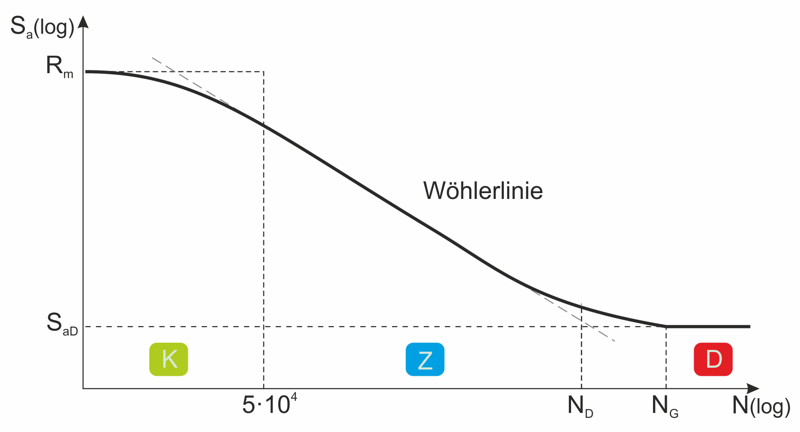The term fatigue strength comes from materials science. It describes the deformation and failure behavior of an oscillating (dynamically) loaded material for a defined number of cycles. Especially at heavily used compression springs it is important to record the fatigue strength.
How is fatigue strength determined?
The fatigue strength is calculated with the help of the Wöhler test, from the results of which the so-called Wöhler curve can be sketched in a fatigue strength diagram. Depending on the deflection stress, it indicates the number of load changes that the material can withstand. The curve in the figure also shows that the break at stresses well below the tensile strenght Rm occurs. The Wöhler curve can be divided into fatigue strength, fatigue strength and short-term strength.

K indicates the range of short-term fatigue strength or short-term strength below about 10 4 until 10 5 Swing play. This fatigue occurs frequently, especially with high plastic strain amplitudes, and leads to premature failure. However, the short-term strength is of little importance for technical requirements.
Z characterizes the range of fatigue strength (short: fatigue strength) or fatigue strength between 104 and depending on the material about 2·10 6 swing play. The Wöhler curve is almost straight in a double logarithmic representation.
D marks the fatigue strength or fatigue strength for short. In ferritic-pearlitic steels, this starts at around 10 6 up to 5·10 6 load changes on. Constant corrosion and the greatly increased temperatures to which a component is exposed mean that the fatigue strength can no longer be guaranteed. In addition to the fatigue strength of highly stressed compression springs, relaxation must also be taken into account as a percentage of the material-dependent loss of force.
Here you can find more information about the relaxation in metal springs , the fatigue strength calculation of compression springs (video) and a few fatigue strength diagrams of different spring materials from the book Roloff / Matek “Maschinenelemente” (page 102/103).
For more information: